Luciano Spalletti has worked wonders since arriving to the scene of Naples in 2021. The Italian manager helped Napoli to a third-place finish last season, and now prepares to lead the closing stages of their title charge in 2023. With some supremely smart acquisitions in the summer working their magic, Gli Azzurri currently sit ten points clear atop the table, and have more than double the points of Serie A’s historical dominator – Juventus. If Spalletti can continue to get his tactics right and maintain the remarkably positive culture he’s built since arriving, Napoli will walk away with the title this year. So with that, here is our analysis of the club from Naples so far in 2022-23.
SYSTEM OF PLAY: 4-3-3
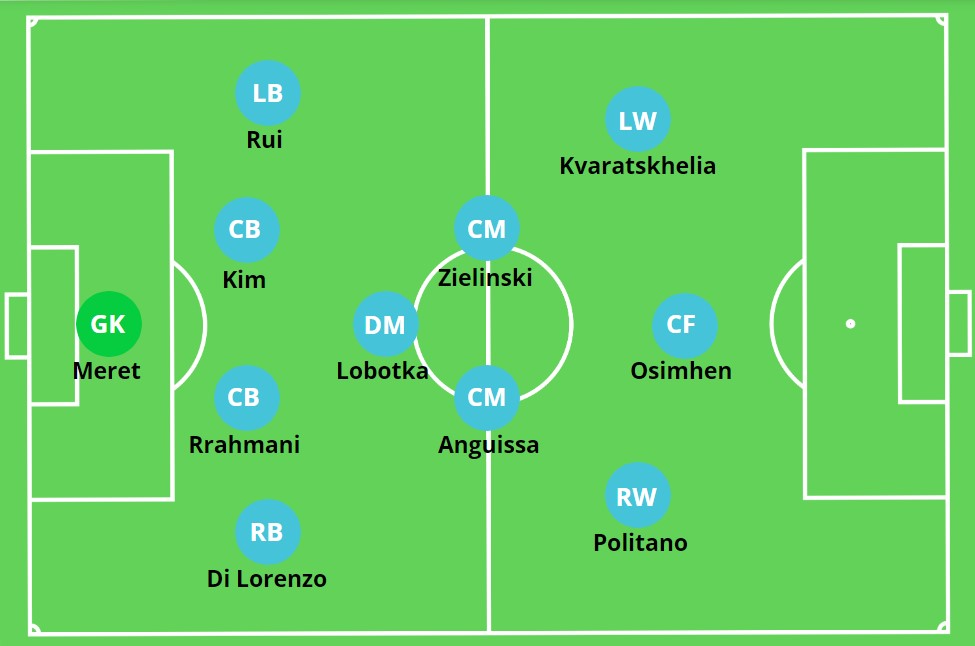
Napoli have operated in a 4-3-3 system throughout the campaign, which often manifests into more of a 4-1-4-1, (as 4-3-3 systems often do!). Throughout the phases, these two compilations of shapes remain fairly consistent, with players holding roles that remain in the ordinal realms of modern-day football. That is, there’s no overly complex variations to their play, and in fact, they are fairly rigid. This goes against the common beliefs of those that have tried but failed to fully study what Spalletti’s team are accomplishing this season.
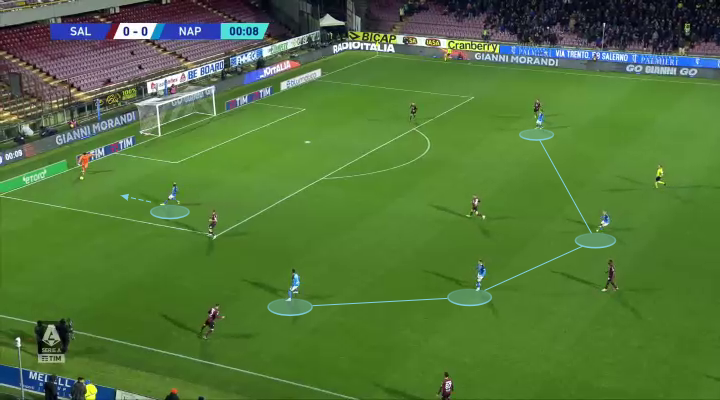
After a Champions League match in October, Spalletti commented that systems in football no longer truly exist, and that instead, teams should look to take advantage of spaces, through a fluid approach.
“Systems no longer exist in football, it’s all about the spaces left by the opposition. You must be quick to spot them and know the right moment to strike, have the courage to start the move even when pressed…”
Many took this to mean that Napoli don’t play in a rigid system of play, and that their players do whatever they want whenever they want on a schedule that works for them, and somehow it all comes together beautifully.
This is not exactly the case. Napoli are, generally, well structured and completely coordinated. They have several principles of play that remain consistent within an over-arching system, and those principles remain fairly rigid between matches. But on both a team and individual level, they also remain fluid in subtly adapting that structure to match the moment. That is where you have players like Stanislav Lobotka, Khvicha Kvaratskhelia and Giovanni Di Lorenzo, who are incredibly astute about seeking spaces, finding gaps, and adapting their positioning, behaviours, and even their role, to the evolution of the match.
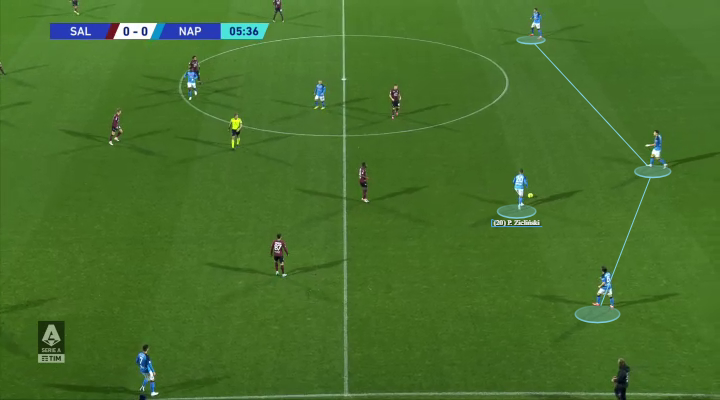
That is precisely what Spalletti spoke to when considering the role of “spaces” in football. If his players always stuck to a pre-assigned list of tasks in their 4-3-3 formation, Napoli would not be where they are today. Why? Because a pre-assigned list of tasks within a certain system fails to fully acknowledge the opposition, not to mention the evolution of what might happen in a match. Instead, Spalletti’s ingrained several automatisms within his players that they can then use to perceive the moment. Their list of things they could do has been clearly assigned, rather than their list of things they must do. He’s not rejecting a system. In fact, he’s played with the same one in 85% of the team’s league matches. Instead, he’s embracing decision making within his system of play.
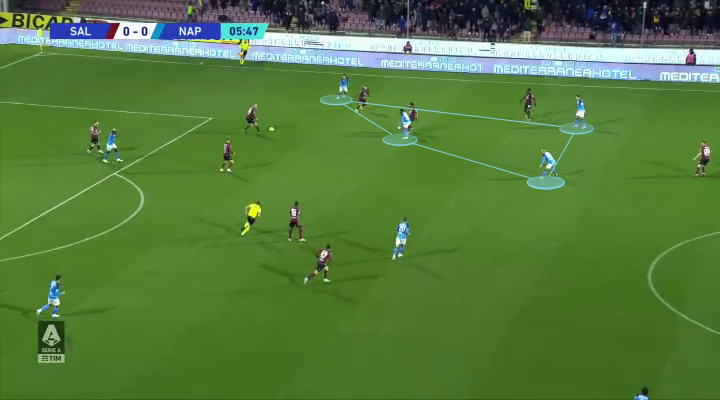
This is the key for any sound tactician to unlock. It’s the freedom of decision making within a pre-constructed set of principles that acts as an over-arching frame. This allows players to use what they’ve learned in practice, but adapt that learning based on their perceptions of ball, opposition, teammates and space.
ATTACKING PRINCIPLES
Embed from Getty ImagesNapoli have dominated all phases of the game this season, with both the most goals scored (46) and the least conceded (14), across their first nineteen matches. For context, that’s over 2.4 scored per game, and 38 more than 19th place Sampdoria.
Embed from Getty ImagesIt all starts at the back end of the pitch, where they remain relatively patient in progressing the ball. Napoli are never afraid to use their goalkeeper and pass the ball backwards, ensuring they’re keeping possession and looking for the right avenues forward. Overarchingly, the key to their success in possession is through close combinations, that often form into diamonds and triangles, creating optimal angles for support.
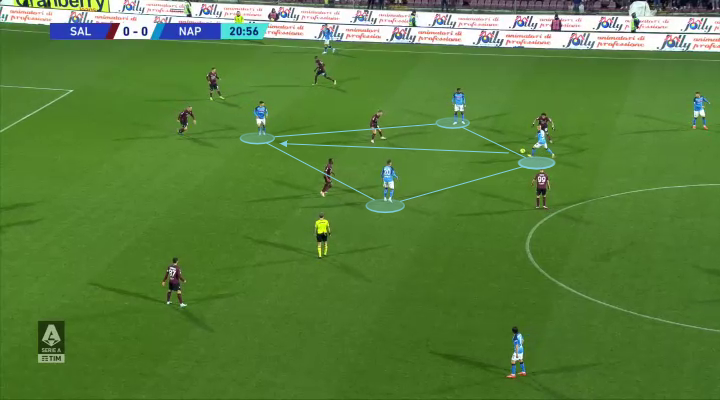
I call this the ‘kite formation’ where you can split a forward pass between a pair of defenders more focused on covering the players on the outside edges of that diamond. It’s great for bounce passes, where those wider diamond players will then immediately advance into space as that “third man”. But we said that they are not overly complex in their approach, and that is true. Close combinations of players allows them to pull off nifty maneuvers that look beautiful, when in reality, it’s what any possession-based team would want to accomplish.
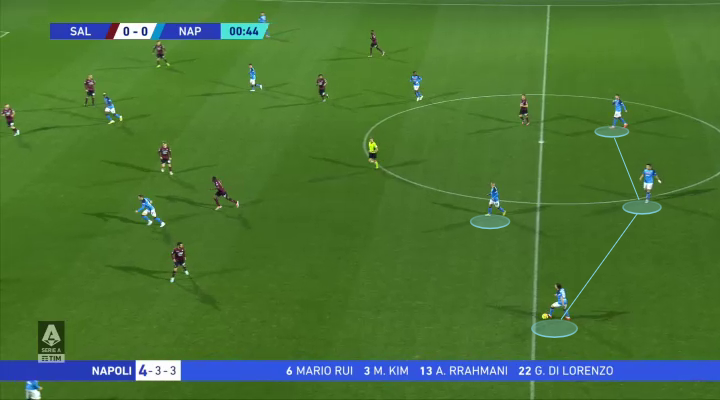
Out from the back, Napoli tend to build up with a back-three, in a typical 3+1. This positions one full-back usually higher and wider up the pitch, as one remains lower and ready to engage in the initial circulation. Stanislav Lobotka is usually the man to sit in front of them, but Andre Anguissa and even Piotr Zielinski will take their moments to slot in front of the defense and get their touches on the ball instead.
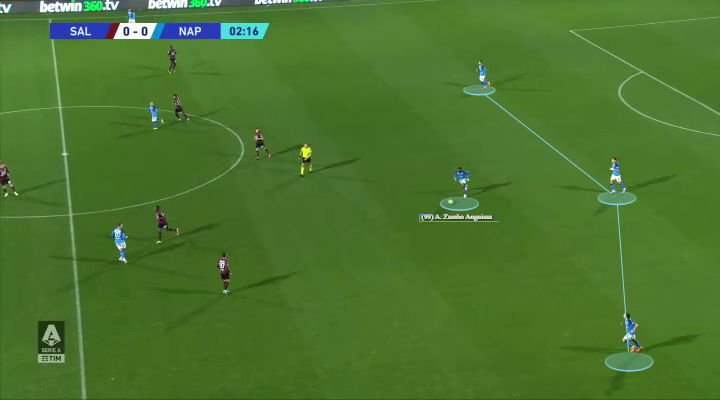
All three central midfielders are phenomenal carriers of the ball, with a close control matched with quick movement of the feet as they glide up the pitch. The centre-backs also like to carry the ball up the pitch, and this happens most frequently when Lobotka slots into the back-three himself.
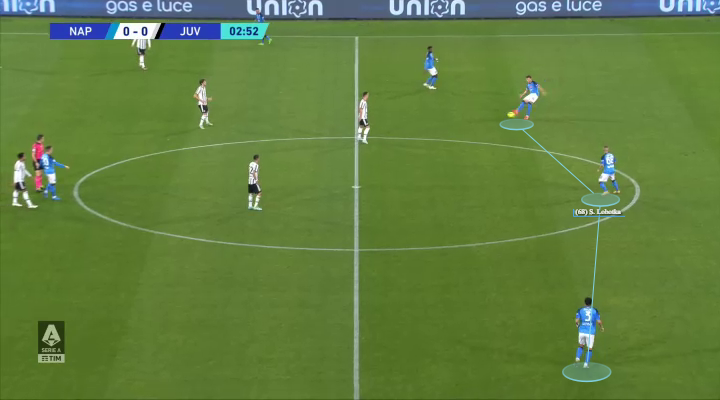
In those cases, both full-backs will usually situate higher and wider up the pitch, and players like Min-Jae-Kim will look for their moments to progress into the wider areas to momentarily compound matters.
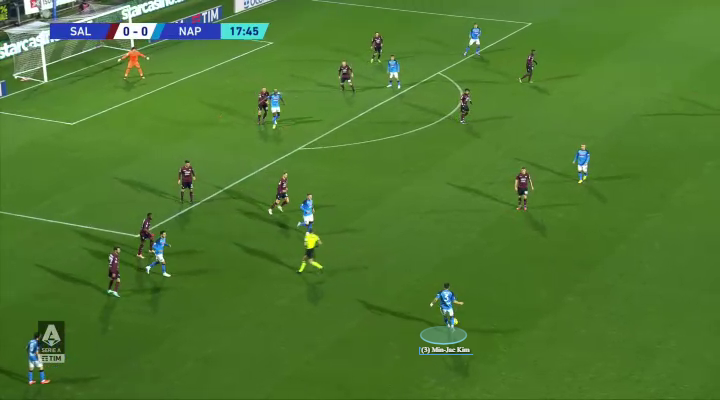
Napoli like to then venture into the wider areas to start their transition from the progression phase into the creation stage, where the likes of Khvicha Kvaratskhelia love to cut inside, but also thrive in combining in tight spaces. The central midfielders themselves are almost always operating in the half-spaces to receive the ball in advanced areas of the pitch, whether that be out from the back or in the final third.
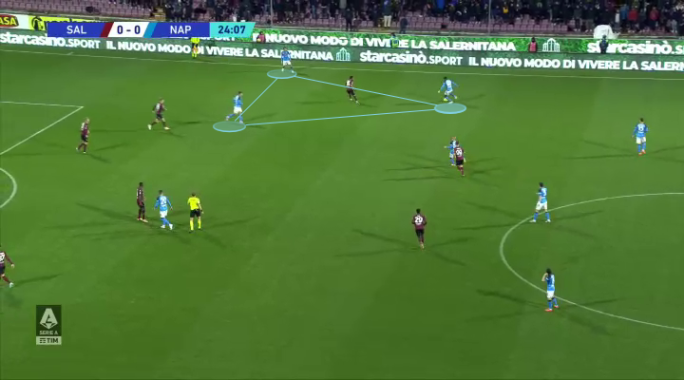
Victor Osimhen remains relatively disengaged until those killer moments where he can inject his pace and power, instead tasked with pushing the opposition’s defensive line back. The Nigerian striker is fantastic at occupying defenders and captivating their attention, allowing dangerous others like Zielinski or Anguissa to suddenly pop up in dangerous areas to bang in a cross.
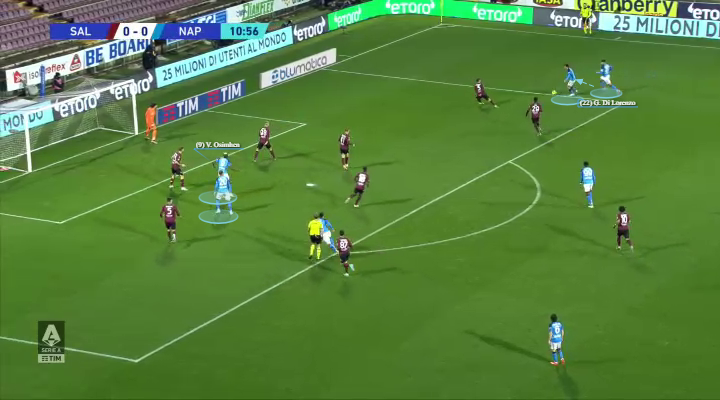
The same could be said of the individual brilliance behind silky smooth Khvicha Kvaratskhelia who combines pure directness down the left wing with moments of pure brilliance in wiggling his way out of trouble. He’s brilliant on both feet, and brilliant at selecting what foot to use in different situations to evade unwanted attention.
Embed from Getty ImagesThe two superstars in the side have 30 goal contributions in 19 matches between them (20 goals + 10 assists), which has been a significant factor behind Spalletti’s success. But it’s not just individual brilliance, but a clear indication toward playing to the individual strengths of players like Osimhen and Kvaratskhelia. Osimhen for example is naturally the first outlet in transition as he runs the channels and allows others to join attacks later on. Kvara meanwhile is the perfect subject for all the wide combinations Napoli endeavour to create, whether they continue to progress down his side, or swiftly switch play to the other.

But you also can’t ignore the centre of the pitch when it comes to Napoli, with their close combinations often masterfully breaking lines even all the way into the final third. As the centre-backs or Lobotka carry the ball forward, Zielinski and Anguissa are adept at finding spaces to receive in between the lines, and even Osimhen can hold up the ball with his back to goal.
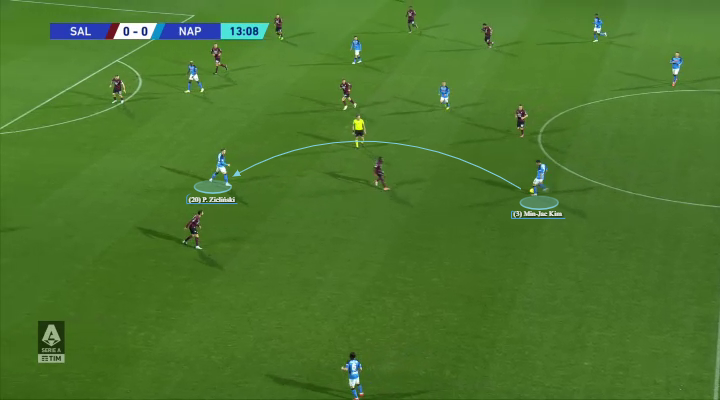
Ten of their goals have even been scored from set-pieces this season, with short corner routines and delightful decisiveness of delivery playing a critical role in their dominance. Spalletti’s short corner tactics featured briefly in our piece ‘The case for short corners‘, illustrating the potential to create wide overloads and keep possession in the final third in a more purposeful manner, rather than creating an instant 50/50 and the inherent potential for a loss of possession.
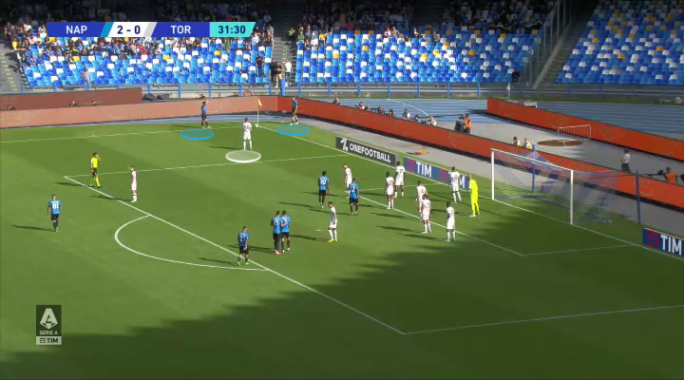
All of this means that Napoli are incredibly adept at generating chances from anywhere and any situation on the pitch. But it also perfectly demonstrates the rigidness behind their principles. You don’t see Kvara just floating wherever he pleases from right-back to goalkeeper to left-wing. Instead, you see him taking players on 1v1 down the left wing when the moment presents itself, cutting inside and doing the same when that becomes the better approach, or simply playing the ball backwards and bouncing it to someone else when that becomes the best option. Spalletti hasn’t rejected his system when concocting his attacking principles; but instead embraced it.
DEFENSIVE PRINCIPLES
Embed from Getty ImagesDefending is always a difficult endeavour without clear organization, communication and coordination, and Spalletti has achieved amazing balance in each of these quests.
At the front end of the pitch, Napoli may typically defend in a 4-4-2, with Piotr Zieliski high alongside Victor Osimhen. This is down to the fact that opposition teams typically set up with two centre-backs in their box, and so Spalletti’s men can immediately press either one off the first pass.

Nevertheless, you may also see I Ciucciarelli setting up their traps in a 4-3-3 or 4-1-4-1, which remain closer to the shapes they impose from mid-block to low. Lobotka will generally sit in front of the defense and screen the back-line, as Zielinski and Anguissa shift into the half-spaces to intercept passes. But as Spalletti would say himself, the key is not necessarily the overarching shape, but rather the principles within that structure.
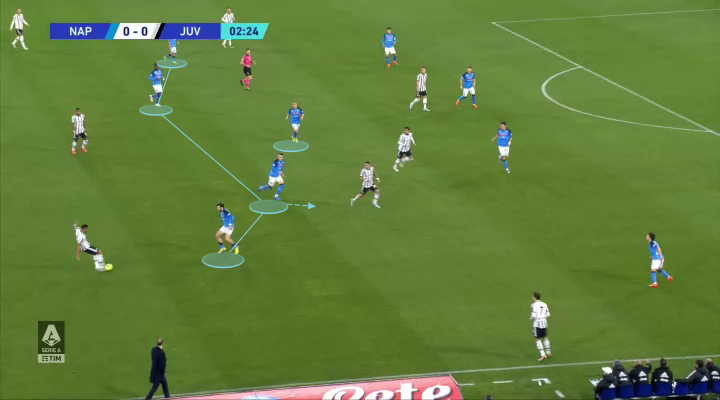
Napoli work to condense all areas of the pitch through close diamond (even rectangle) shape constructions, positioning several players around the ball. This takes form most prominently in the wide areas, but the entire team are quick to narrow in transition and close any gaps available for exploitation.
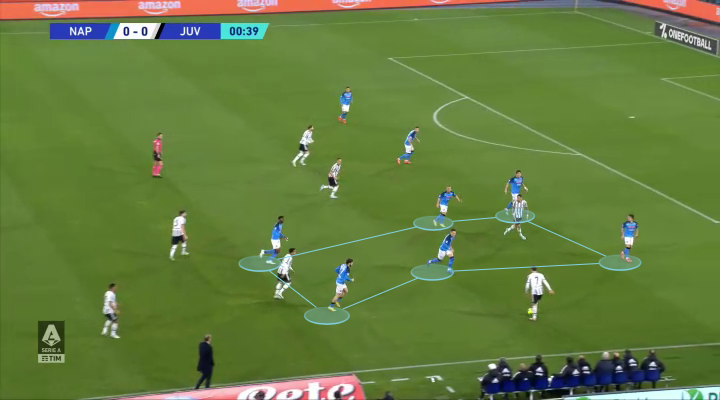
In fact, Napoli’s stunning record of just 0.73 goals conceded per game may stem from their ability to win back the ball soon after losing it. Min-Jae Kim has made a frequent habit of stepping up from his position at the right moments to completely annihilate an unaware attacker, and never shies away from a tackle.
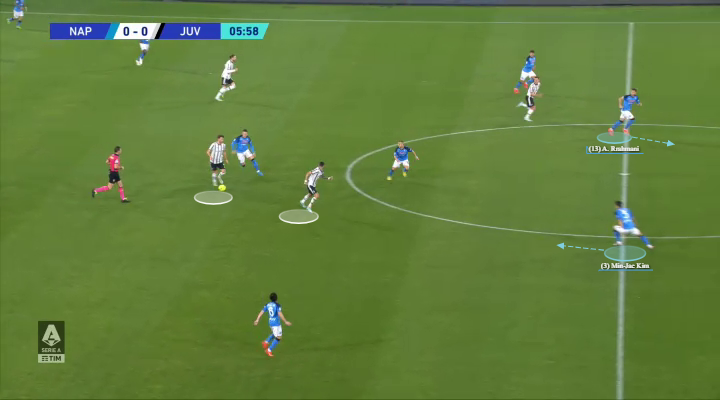
His timing of tackles and pressures is second to none in the side (85.7% tackle success!), and ensures that all the attack-minded players have less to do in galloping back in defense. Stanislav Lobotka remains equally important to those defensive transitions, making more ball recoveries than anyone else in the side (6.95 per 90). The fact that their possession is at the highest in the division (61.7%) is a clear indication of their success in winning back the ball so swiftly after turnovers.
Embed from Getty ImagesPerhaps the one area for improvement from a defensive perspective would be back to the front end of the pitch, where their press can be broken depending on the positioning of Lobotka and Anguissa in fully covering the half-spaces. While the 4-4-2 might be better for stopping the success of the first few passes, it leaves Lobotka and Anguissa with much ground to cover if those front players find themselves beaten.
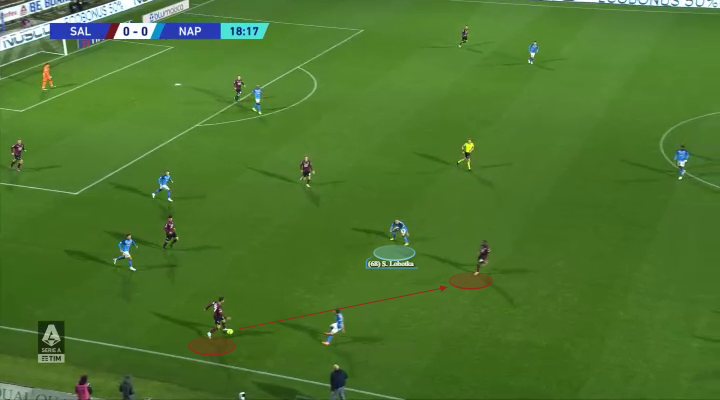
It is however practically impossible to cover all the spaces imaginable when enacting high-intensity pressure, and Napoli usually accomplish what they want in pressing high up the pitch. That is – forcing turnovers and errors, such as long passes that go no further than to Napoli’s pair of centre-backs. This is one more way in which they ensure control over their matches, and limit the opposition to achieve any sort of rhyme or rhythm to their play. It’s also how they’ve conceded just 14 goals in 19 matches, on course for something truly remarkable and ground-breaking come the end of the season.
CONCLUSION
Embed from Getty ImagesNapoli have been far and away the best side in Serie A this season, clearly playing with confidence bursting through their veins. It will surprise no one that they top the charts when it comes to possession, goals, and the lack of goals they’ve conceded, with Spalletti’s side sitting ten points clear of second-place Inter. But the chaos that Napoli impose on the pitch is not the actions of individuals doing whatever they want whenever they please.
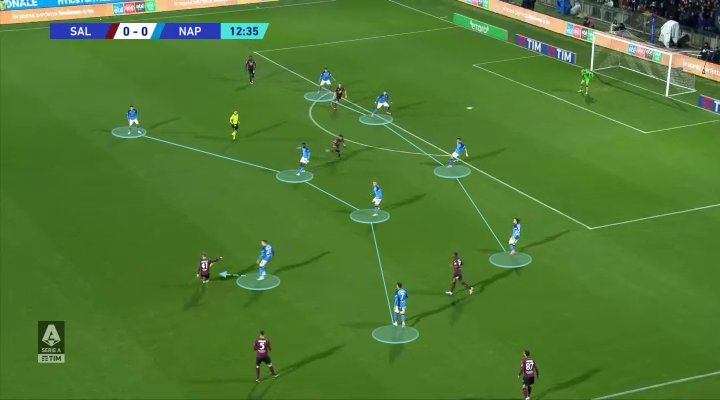
Spalletti has enacted freedom of decision making only through utilizing the rigidness of a system and clearly defined principles as a starting place. Without that system, the entire functionality of creativity could crumble. But that’s not Spalletti’s point. The point is that the system is not the most important part of tactics in football, and instead that the game is more about spaces. His own set of players are masters of perceiving space and designing their behaviours to match the moment, working to create chaos within that well constructed system.
Embed from Getty Images
So there it is! Our tactical analysis of Luciano Spalletti’s Napoli in 2022-23. Be sure to check out more of our Team Analyses, and more from Rhys Desmond on @mastermindsite and @desmondrhys. Thanks for reading and see you soon!
-> Luciano Spalletti – Napoli – Tactical Analysis (2021-22)

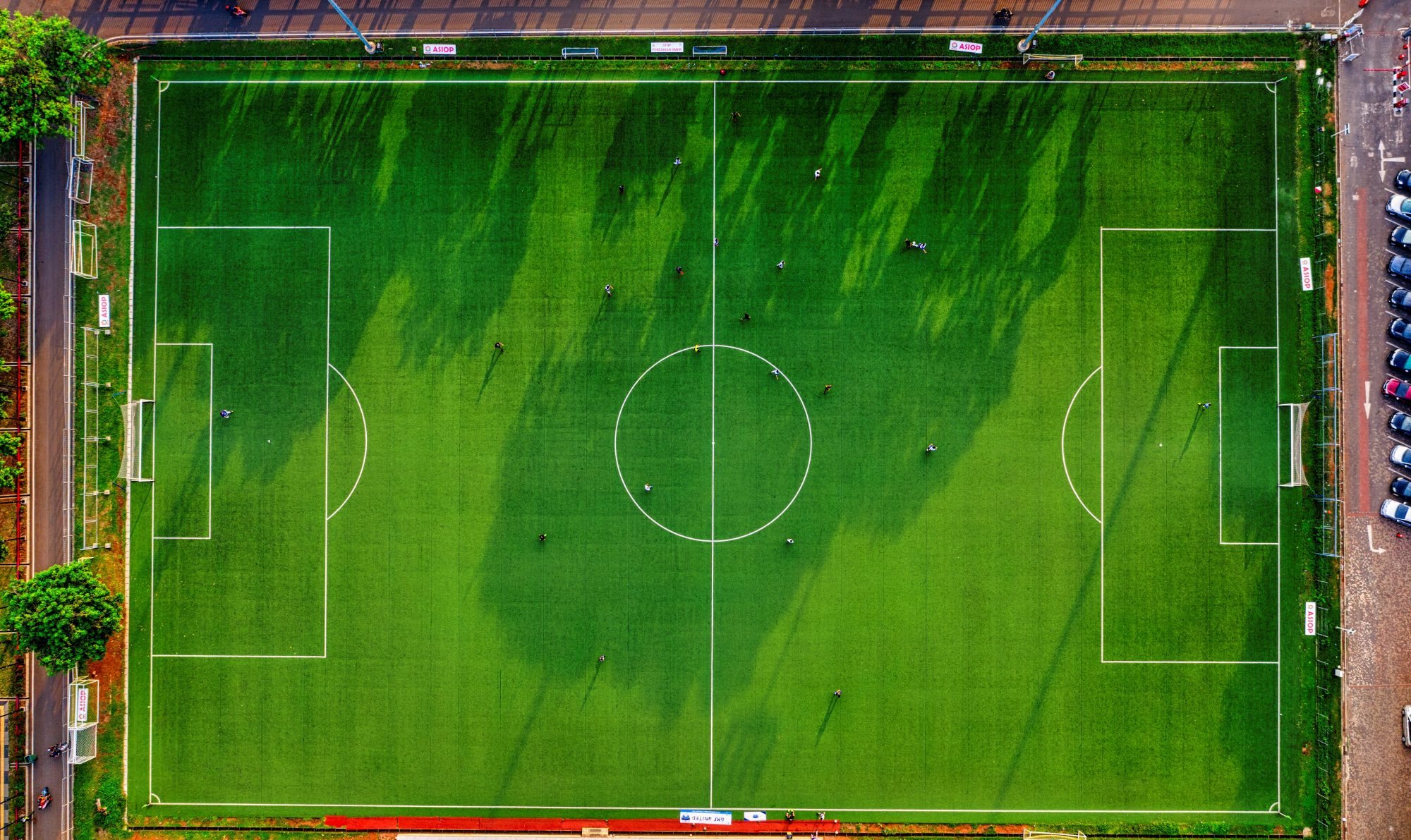

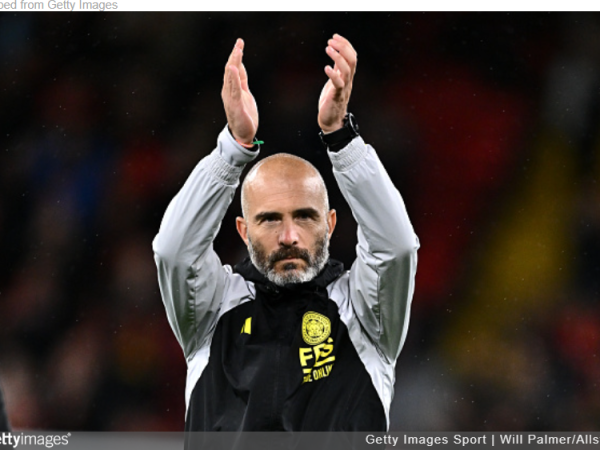

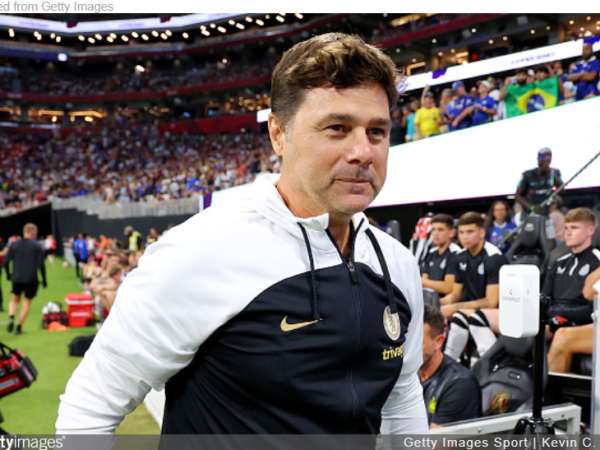
2 thoughts on “Luciano Spalletti – Napoli – Tactical Analysis (2022-23)”